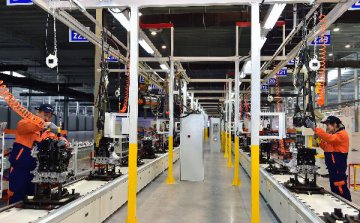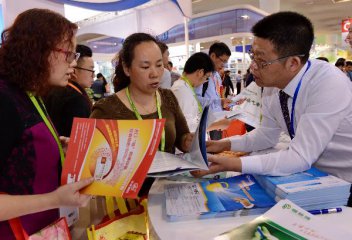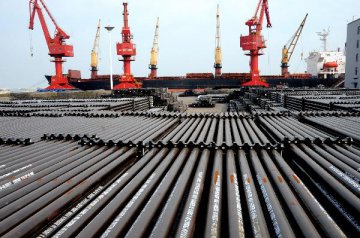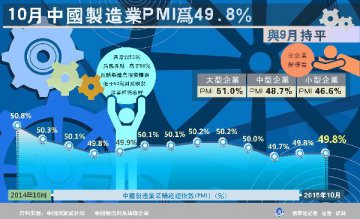
China's factory activity picked up a bit in December as emerging engines shored up growth, official data showed Friday.
China's manufacturing purchasing managers' index (PMI) came in at 49.7 in December, up from 49.6 in November, according to data released by the National Bureau of Statistics and the China Federation of Logistics and Purchasing.
A reading above 50 indicates expansion, while that below 50 represents contraction. Although the low oil prices and tight cash flow at the end of the year have put heavy pressure on China's manufacturers, strong recovery was seen in production and market demand.
The production sub-index posted at 52.2 in December, up from 51.9 in November, showing accelerated growth in production. The sub-index for new orders came in at 50.2, back to expansion territory and up from 49.8 in November, indicating demand has improved slightly.
While traditional low-cost manufacturing ran out of steam, high-tech manufacturing bucked the trend. The sub-index for high-tech manufacturing rose to 53 in December, with its average sub-index for 2015 beating the overall PMI for manufacturing by 2.9 percentage points.
The data showed China's industrial upgrades and restructuring have been continuously advancing, said NBS statistician Zhao Qinghe. Manufacturing of computers and telecommunication equipment continued to expand, with the indices for the sectors remaining above 52.
"The figures showed signs of stabilization in China's economy," said Zhang Liqun, analyst with the China Federation of Logistics and Purchasing. Meanwhile, China's non-manufacturing activity expanded strongly in December, indicating a bigger role for the service sector in supporting the slowing economy, Friday's data showed.
The PMI for the non-manufacturing sector came in at 54.4 in December, up from 53.6 in November and also the highest in 2015. Industries related to household consumption, such as retail, postal and express delivery services, storage and distribution services, as well as Internet software, all expanded due to a holiday and year-end promotion sales boom, Zhao said.
Financial activities including banking, securities trading and insurance also posted strong expansion. The sub-index for new orders in services climbed to 51.2, up 0.9 percentage points from November, showing demand rallied in the service market, Zhao said.
The non-manufacturing PMI tracks business activities of both the service and construction industries. China's economy expanded 6.9 percent in the first three quarters, in line with the official growth target but still the lowest reading since the second quarter of 2009. To prop up the economy, the government has rolled out a stream of policies.
The People's Bank of China (PBOC) has cut benchmark interest rates five times in 2015 and lowered banks' reserve requirement ratio four times. At the annual Central Economic Work Conference last month, the central government vowed to push forward "supply-side structural reform" in 2016 to support growth through "adding new supply, creating new consumption and forming new growth momentum."
This means more tax cuts, lower corporate borrowing costs, incentives for specific industries, tackling factory overcapacity and property inventories, as well as easing administrative restrictions. In its working paper released earlier in December, the PBOC projected its baseline forecast for 2016 growth at 6.8 percent, slightly lower than its forecast of 6.9-percent expansion for 2015.
It expected the number of positive factors to gradually increase despite downward pressure on the economy. Supportive factors such as the recovery of real estate sales, lagging effects of macro and structural policies and some modest improvement in external demand would help underpin broader growth, the paper said.
























Latest comments